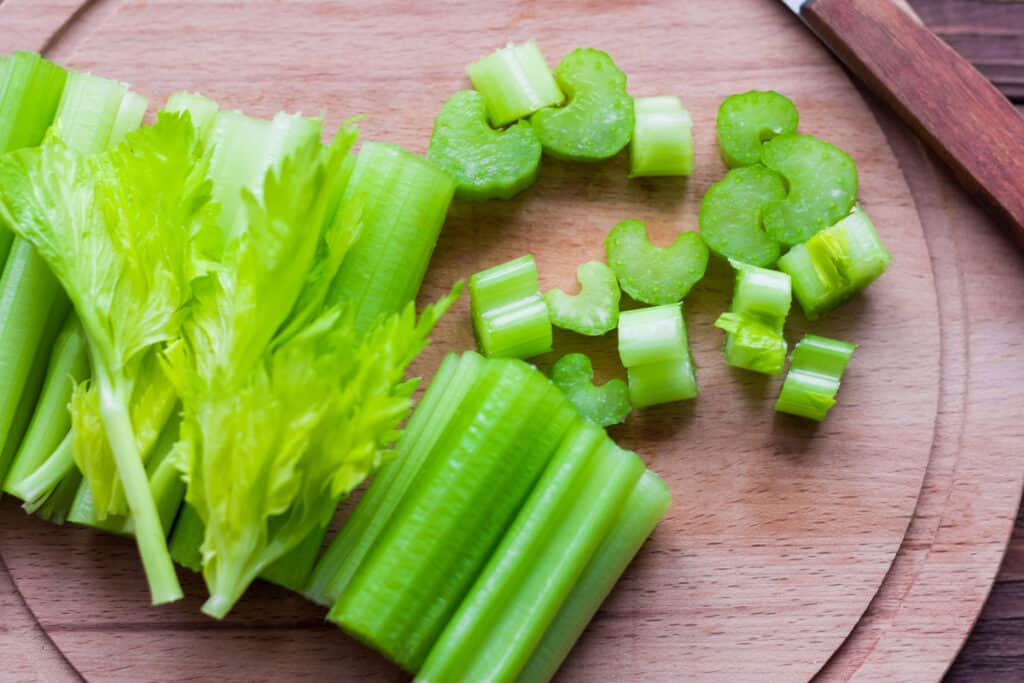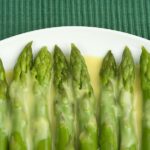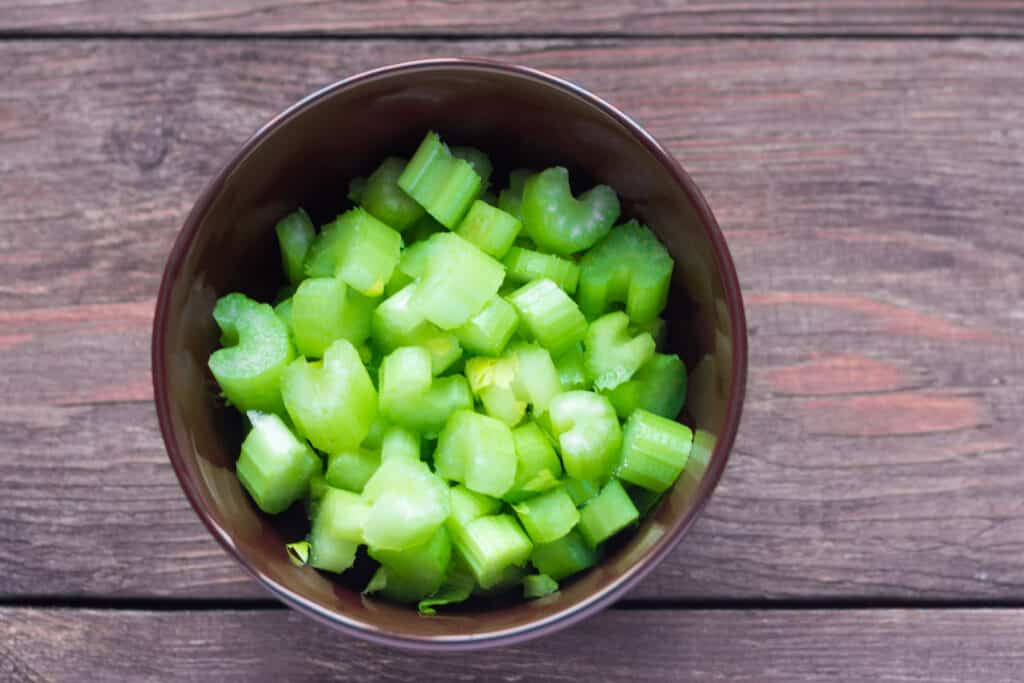
Celery can be eaten raw or cooked. Celery brings texture and a mild flavor to salads, hors d’oeuvres, soups, stuffings, stews, and stock. It can be steamed, braised, or sautéed and served as a side dish.
Celery tastes best when it comes to harvest in cool weather, late spring, or in autumn.
How to choose celery
- Select celery with crisp, firm, bright stalks in tightly formed bunches. The ribs should be straight and rigid. If the leaves are attached, they should be fresh and green.
- Avoid celery that is soft, dry, damaged, or that has brown patches or yellowing. Overly large celery bunches with dark green stalks may be bitter and stringy. The darker the color of celery the stronger the flavor.
Kitchen Helpers from Amazon:
- Oster Vegetable Steamer
- Chef’s Knives Set of 6
- EZ Off Jar Opener for Weak Hands
- Pepper Core Remover Stainless Steel
- Kitchen Utensils – Set of 35
How to store celery
- Keep celery in a perforated bag in the refrigerator crisper for up to one week.
- The stalks and leaves should remain attached until you are ready to use them.
- If celery becomes limp when stored, you can restore its crispness by trimming the rib ends and soaking the stalks in ice water for 10 to 20 minutes.
- You can freeze celery for up to 3 months: wash and cut the stalks into 1 inch (2.5 cm) lengths, blanch them for 3 minutes, cool, drain, and pack them into plastic bags. Frozen celery can only be used in cooked dishes.
How to prepare celery
- Trim the base and wash the stalks only when you are ready to use them.
- Peel or pull away tough outer strings before serving raw or cooking.
How to get the most out of one bunch of celery
- Trim off the leafy top and set it aside for flavoring soups or stock or for use in salads.
- Remove and dice the coarse outer ribs then combine them with diced carrots and onions and herbs to make mirepoix—a tasty seasoning for sauces and stews—or a bed for fish or braised meats.
- Sauté tender outer ribs in butter, season with salt and pepper, and serve with roast pork or lamb.
- Use the tiny leafy ribs around the center for a raw vegetable hors d’oeuvre.
- Split the innermost ribs—called the heart—and braise in chicken or beef stock, add fresh ground pepper and chopped parsley and serve as a side dish with a sweet, nutty flavor.
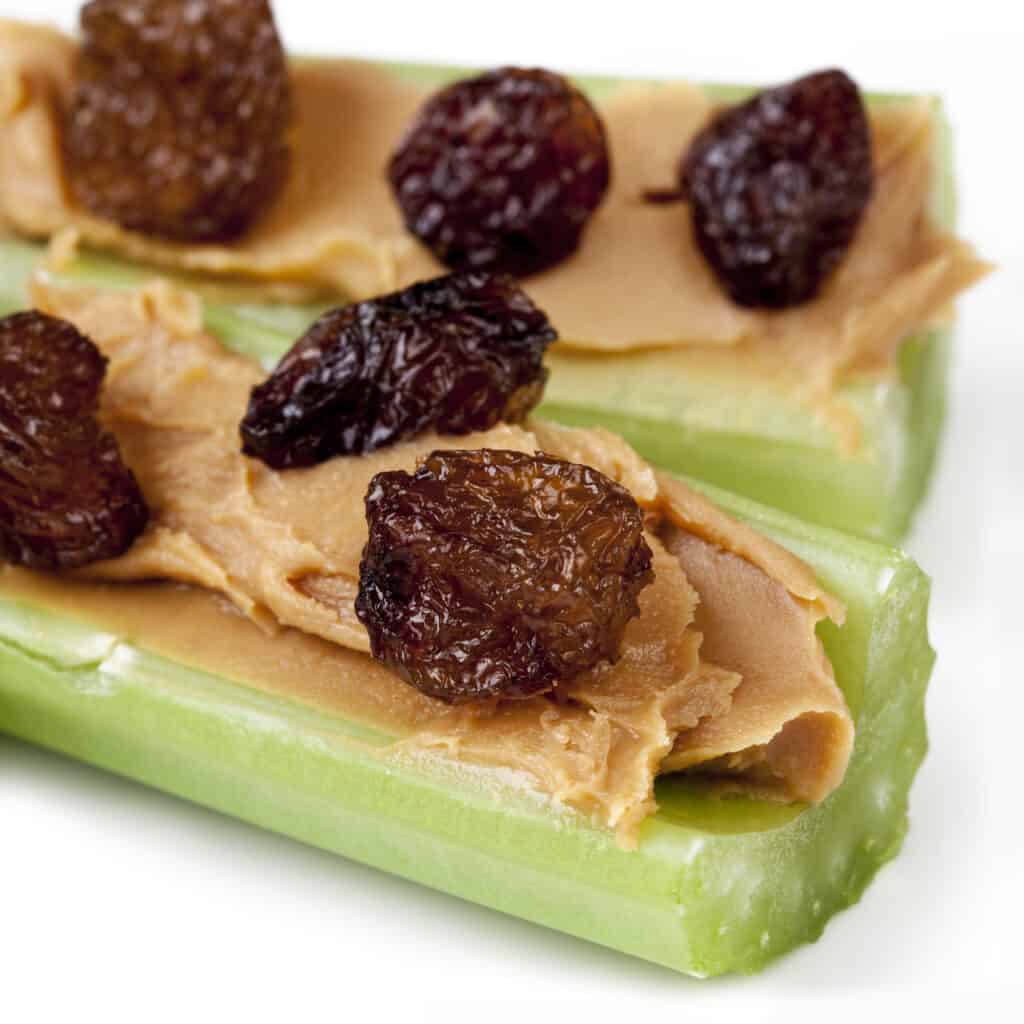
Celery serving suggestions
- Celery can be served raw or cooked.
- Serve raw celery as a snack, appetizer, or in a salad. Stuff raw celery stalks with cheese, seafood mix, or deviled eggs.
- Stuff raw celery stalks with mashed Roquefort or other blue cheese.
- Add raw celery to sandwiches.
- Add diced celery to egg salad, chicken salad, tuna salad, and potato salad, and to mixed vegetables.
- Combine diced celery, unpeeled red apples, and chopped walnuts bound with mayonnaise to make Waldorf salad.
- Make a salad of finely sliced celery, thin flakes of Parmesan cheese, oil, lemon juice, and pepper.
- Celery leaves can be used to flavor salads, soups, sauces, or bouillons. Add celery leaves like parsley to meat dishes.
- The classic French mirepoix—which includes celery– is a mixture of diced aromatic root vegetables used to flavor sauces, soups, and stews.
- Celery seeds are slightly bitter and have a concentrated celery flavor. Use whole or crushed celery seeds in stuffings, poached vegetables, crackers, marinades, and sauces.
- Celery salt is a seasoning derived from ground dried celeriac.
Celery cooking suggestions
- Simmer celery sliced or diced in a covered container for 5 to 10 minutes. Whole bunches cut into quarters or individual ribs will require 10 to 20 minutes to simmer.
- Steam celery for 10 to 20 minutes.
- Sauté or stir-fry small pieces of celery until tender.
- Use celery leaves and stems to flavor soups, sauces, stews, pasta, tofu, quiches, omelets, and rice.
- Celery stems can be boiled, braised, fried, or baked. Stir-fry diagonally sliced celery until crisp-tender.
- Braised celery can be gratineed, topped with béchamel sauce or with melted butter.
- Braised celery hearts are a good companion for game, duck, or pork.
- Celery stuffing: combine equal parts finely chopped celery, milk, or chicken broth—add soft bread crumbs until the mixture has the moisture you like, and season with sage, thyme, marjoram, and pepper.
How to sauté celery
- Clean and trim the celery and cut the stalks into thin pieces
- Heat 6 or more tablespoons of unsalted butter in a saute pan over medium heat.
- Add the celery and salt and pepper to taste.
- Cook shaking the pan occasionally until the celery is tender, about 5 minutes.
Celery can be sautéed with other vegetables for added flavor.
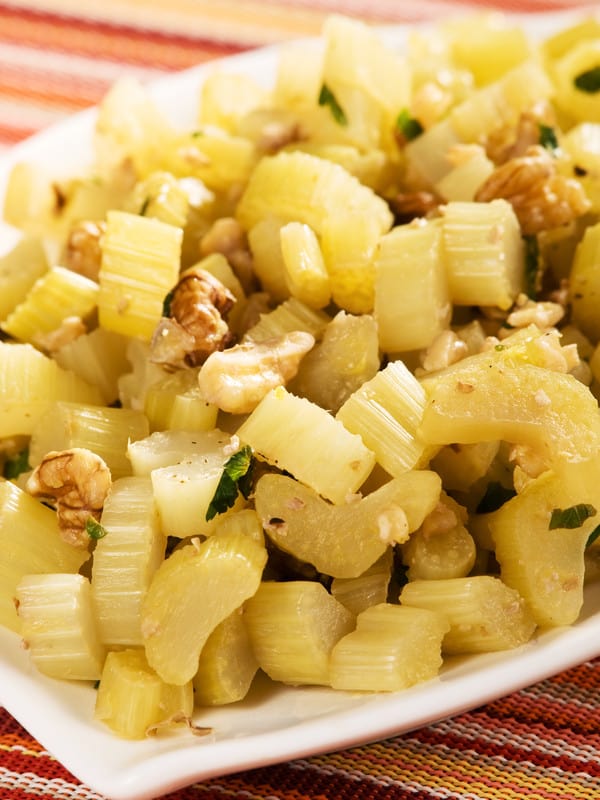
How to oven-braise celery
- Clean and trim the celery and cut the stalks into pieces 2 inches long.
- Add 2 tablespoons of olive oil or butter to a large ovenproof skillet.
- Put the skillet on the stovetop over medium heat.
- When the oil or butter is melted, add the celery and cook stirring occasionally for 2 minutes.
- Sprinkle with salt and pepper to taste and add 1 cup of vegetable stock and bring to a boil.
- When the stock comes to a boil, transfer the skillet t the oven and cook until the celery is tender, about 15 minutes.
- Add liquid if it evaporates before the celery is tender.
- Serve hot or warm garnished with chopped parsley or fresh dill.
How to braise celery hearts
- Celery hearts are the stalks at the core of the bunch; these often go unused,
- Split 4 celery hearts lengthwise.
- Melt 4 tablespoons of unsalted butter in a heavy skillet or saucepan.
- Add the celery hearts and sprinkle with salt then add ¼ cup of chicken or beef stock.
- Cook the hearts over medium heat turn the hearts once with two spoons; cook until tender, about 30 minutes.
- Remove the hearts to a serving dish then boil the pan juices down to about 1/3 cup and then pour over the celery.
- Season with pepper and sprinkle with parsley and serve.
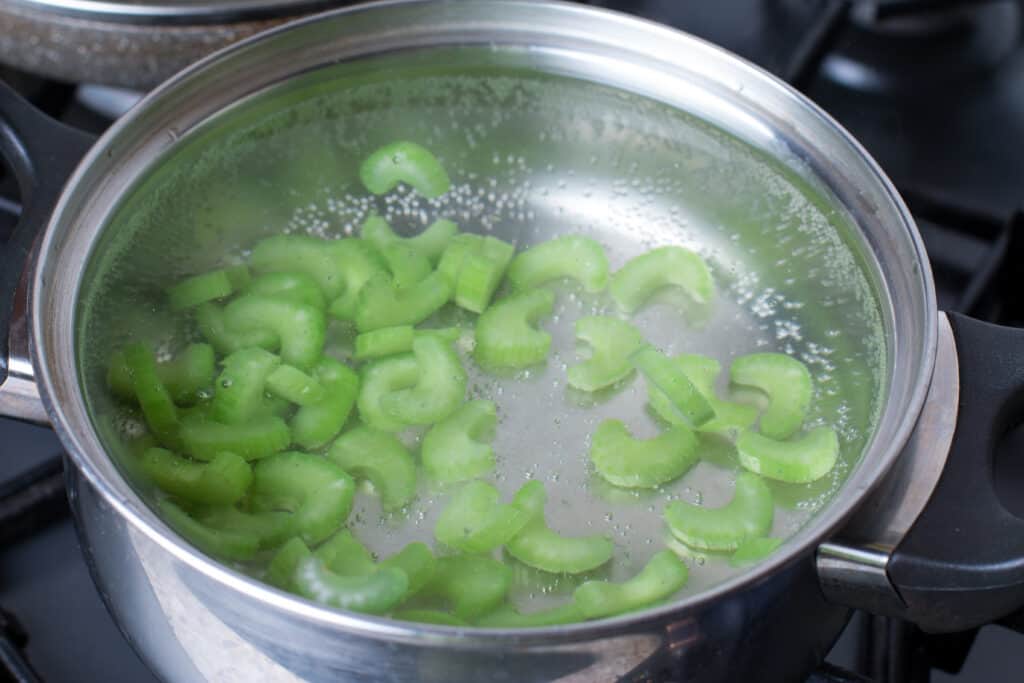
How to boil celery
These directions add a special touch to plain boiling celery.
- Clean and trim the celery and cut the stalks into small crescents
- Place the celery in a pot. Add just enough water to cover the celery.
- Bring the water to a boil over medium-high heat and cook the celery until it is just tender, about 5 minutes.
- Drain away the water and add butter and cream of milk with salt and pepper to taste.
Celery flavor partners
- Celery has a flavor affinity for blue cheese, butter, chicken soup, fish Gruyère cheese, poultry, and shellfish.
- Serve celery alone or mixed with carrots, peas, onions, tomatoes, sweet bell peppers, mushrooms, potatoes, or any combination of these.
- Season celery with salt, pepper, onion, garlic, mustard, paprika, parsley, dill, basil, tarragon, or thyme.
Celery nutrition
- Celery is an excellent source of potassium and contains vitamins A and C.
- There are 8 calories one large outside stalk of three inside stalks of celery.
Types of celery
There are two basic types of celery divided by color: green and golden.
- Green celery—also called Pascal celery–is the most common celery. Pascal celery has large, heavy, green ribs and green leaves. The outer ribs are good for dicing and cooking and the inner ribs, or heart, can be eaten raw or braised. Pascal celery is often found year-round, but its peak season is mid-summer to late fall. Golden celery is most abundant in the late fall.
- Golden celery—also called blanched or white celery—has ribs that are white and leaves that are yellow. Golden celery is sometimes sold as celery “hearts.” Golden celery is delicious raw and may also be used for braising. Golden celery is sometimes blanched or bleached under a layer of soil or paper (this prevents chlorophyll from developing and turning the stalks and leaves green), but there are also self-blanching varieties of golden celery. Europeans seem to prefer golden celery, and Americans seem to prefer green celery.
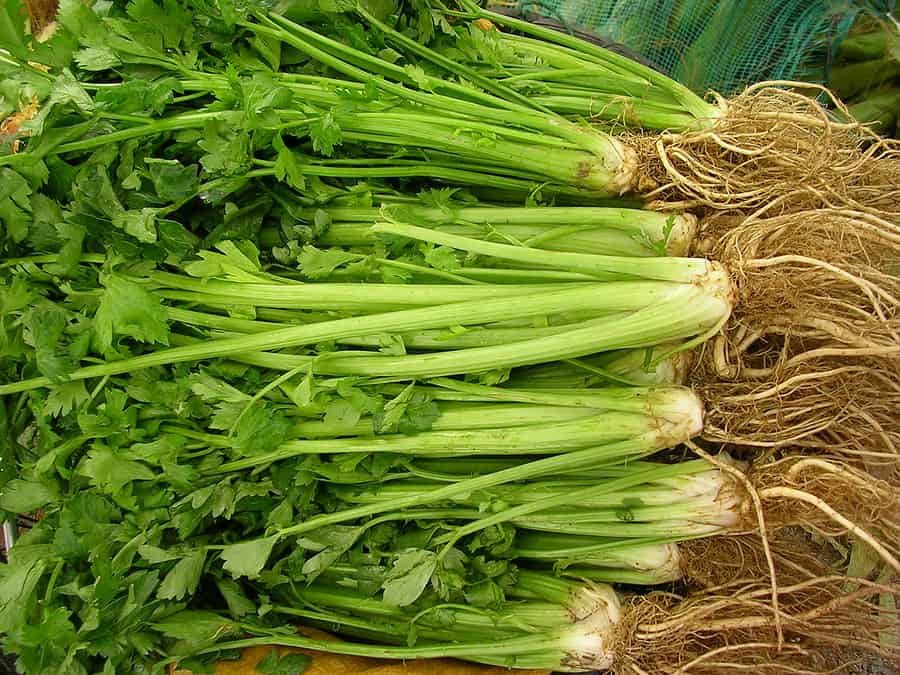
Get to know celery
- Celery is a biennial grown as an annual. Celery grows in a tight rosette of leaf stalks each topped with many divided leaves. The stalks usually grow from 8 to 18 inches (20-40 cm) tall. The green outer stalks and pale green inner stalks are furled around a central heart where the ribs are thin and the leaves are tiny.
- Celery stalks, leaves, and seeds (which come in the second year after the plant has matured and flowered) are all edible. Celery seeds are aromatic and often used in cooking.
- The first mild-tasting celery was cultivated in Italy in the late sixteenth century and used as a seasoning. In the eighteenth century, Europeans began to eat celery as a raw vegetable. Celery was introduced into the United States in the nineteenth century.
- Wild celery—the ancestor of cultivated celery—grew first in the marshy regions of Europe and Asia. It was bitter tasting and used in elixirs in ancient Greece and Rome and during the Middle Ages.
- The Latin and botanical name for celery is Apium graveolens var. dulce. The Latin Apium is derived from the Celtic word for water, apon, which refers to wild celery’s watery habitat; graveolens means aromatic; the variety name dulce means sweet or pleasant tasting. Wild celery is bitter. Cultivated celery is sweet or mild-tasting.
The botanical name for celery is Apium graveolens var. dulce.
Also of interest:
How to Harvest and Store Celery
Tasty Ways to Cook and Serve Celery
Celery Growing Problems Troubleshooting
How to Plant, Grow, and Harvest Celeriac
Five Ways to Cook and Serve Celeriac
Articles of interest:
Best Herbs for Container Growing
Garden Planning Books at Amazon:
- Vegetable Garden Almanac & Planner
- Kitchen Garden Grower’s Guide Vegetable Encyclopedia
- Vegetable Garden Grower’s Guide
- Tomato Grower’s Answer Book
More kitchen tips:
Bring your harvest to the table. Kitchen prep tips and easy recipes for the vegetables you grow. Click below for vegetable prep and recipes you can use now.
- Almonds
- Apples
- Apricot
- Aprium
- Artichoke
- Arugula
- Asparagus
- Avocado
- Bamboo Shoots
- Banana
- Basil
- Beans, Dried
- Beans. Long
- Beans, Shell
- Beans, Snap
- Beets
- Bitter Melon
- Blackberry
- Bok Choy
- Broccoli
- Broccoli Raab
- Brussels Sprouts
- Cabbage
- Cardoon
- Carrots
- Cauliflower
- Celeriac
- Celery
- Chard
- Chayote Squash
- Cherimoya
- Cherries
- Chestnut
- Chickpea
- Chinese Cabbage
- Chives
- Cilantro
- Citron
- Clementine
- Collards
- Coriander
- Corn, Sweet
- Corn, Baby
- Corn Salad, Mache
- Cranberry
- Cress
- Cucumber
- Daikon
- Dandelion
- Dill
- Eggplant
- Endive, Belgian
- Endive and Escarole
- Fava Beans
- Fig
- Florence Fennel
- Garlic
- Ginger
- Grapefruit
- Grapes
- Guava
- Horseradish
- Jerusalem Artichoke
- Jicama
- Jujube
- Kale
- Kiwifruit
- Kohlrabi
- Kumquat
- Leeks
- Lemongrass
- Lemons
- Lettuce
- Lime
- Mache (Corn Salad)
- Mandarin Orange
- Mango
- Maple Syrup
- Marjoram
- Melons
- Michihili
- Mint
- Mizuna
- Mushrooms
- Mushrooms, Cremini
- Mustard Greens
- Napa Cabbage
- Nectarine
- Okra
- Olives
- Olive oil
- Onions
- Oranges
- Oregano
- Parsley
- Parsley Root
- Parsnips
- Passion Fruit
- Pawpaw
- Peaches
- Pears
- Peas, Garden Snap
- Peas, Snow
- Pei Tsai
- Peppers, Chili
- Peppers, Sweet
- Persimmon
- Pineapple
- Pineapple Guava
- Plantain
- Plums
- Pluots
- Pomegranate
- Potatoes
- Prickly Pear
- Pumpkin
- Quince
- Radicchio
- Radishes
- Raspberries
- Rosemary
- Rhubarb
- Rutabaga
- Sage
- Salsify
- Sauerkraut
- Savory
- Shallots
- Sorrel
- Spinach
- Squash, Summer
- Squash, Winter
- Strawberries
- Sunchokes
- Sunflower
- Sweet Potato
- Swiss Chard
- Tangerine
- Taro
- Tarragon
- Thyme
- Tomatillo
- Tomato
- Turnip
- Turnip Greens
- Yams


